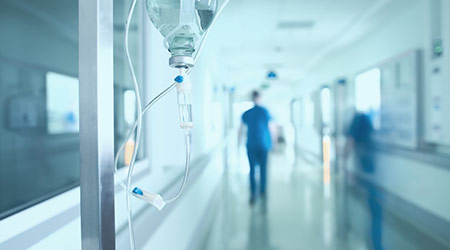Patient safety and satisfaction relies on more than just internal operations and care, it spans all the way to the infrastructure of the healthcare facility itself. Having an intelligent infrastructure in place can help create healthier, better outcomes for patients and their families, especially when it comes to an emergency event such as a fire or natural disaster.
Preparing for expected and unexpected threats in advance is the best way to ensure damages are as minimal as possible. Healthcare facilities can prepare by integrating smart technologies into existing infrastructure to improve the safety of all occupants. Below are a few ways healthcare leaders can utilize smart infrastructure for improved safety.
Visitor and patient monitoring
Video surveillance and access control are basic security features that, when used to their full potential, provide maximum ROI. In a healthcare facility, there’s a revolving door of visitors and patients, making it difficult to track who is entering and exiting. Through video surveillance and access control, security personnel can better track and control activity throughout the facility. Video surveillance can be used to monitor suspicious behavior -- and when paired with analytics -- can trigger real-time alerts, remote arm/disarm, manage occupant access and monitor video in real-time for fast response and prevention. With access control, you can ensure that only approved personnel are granted entry into certain areas of a healthcare facility, such as the pharmacy. More insight into facility occupants can make all the difference in an emergency and everyday management.
Evacuations and facility lock downs
Over the past year devastating hurricanes forced several hospitals to evacuate patients and staff, a task both difficult and potentially dangerous for many patients. Innovative technologies such as smart lighting and addressable notification can make these hectic situations run smoother.
Smart lighting can be used to light the path to safety for patients and visitors unfamiliar with the hospital layout and emergency plan. They can also be used to signal an intruder, for example, all lights could be programmed to turn blue to signify to patients, staff and visitors that they should shelter in place. Additionally, smart lighting can also be beneficial in an everyday setting allowing patients to control their own lighting in their rooms for optimal comfort and improved healing.
Another helpful technology used for evacuation plans is mass notification. In the event of an emergency, a universal message or a personalized message tailored to a specific area, building, floor or room can be delivered through a system providing clarity on what the plan of action should be – shelter in place or evacuate. Similar to smart lighting, mass notification provides value outside of emergency situations as well. Having technologies like visible signage throughout a facility can help staff and patients navigate through the multiple facilities and areas more efficiently. For patients and their loved ones, it is one less thing they have to worry about, for staff it allows them to act more efficiently allowing them to spend more time caring for patients.
Black outs
In the event of a natural disaster healthcare facilities can often lose power. In addition to losing lights, computers and temperature controls, this could potentially mean loss of power on lifesaving equipment. Distributed energy storage releases stored energy during a power outage to keep a facility up and running -- a crucial feature in any healthcare facility. Having this technology in place can help mitigate the impact of an emergency and save valuable time and money.
An intelligent infrastructure can make all the difference when it comes to safety. It provides healthcare providers with more options for operational and safety technologies to help make a facility more comfortable for its patients. For healthcare facilities, the satisfaction and healing of its patients is the number one goal, so making updates to infrastructure now can lead to a better future for patients and staff.
Fawn Staerkel, director of healthcare, Johnson Controls Buildings Solutions North America.

 Grounding Healthcare Spaces in Hospitality Principles
Grounding Healthcare Spaces in Hospitality Principles UC Davis Health Selects Rudolph and Sletten for Central Utility Plant Expansion
UC Davis Health Selects Rudolph and Sletten for Central Utility Plant Expansion Cape Cod Healthcare Opens Upper 2 Floors of Edwin Barbey Patient Care Pavilion
Cape Cod Healthcare Opens Upper 2 Floors of Edwin Barbey Patient Care Pavilion Building Sustainable Healthcare for an Aging Population
Building Sustainable Healthcare for an Aging Population Froedtert ThedaCare Announces Opening of ThedaCare Medical Center-Oshkosh
Froedtert ThedaCare Announces Opening of ThedaCare Medical Center-Oshkosh